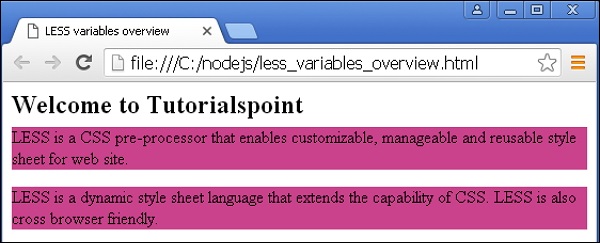
- Less Basic Tutorial
- Less - Home
- Less - Overview
- Less - Installation
- Language Features
- Less - Nested Rules
- Less - Nested Directives and Bubbling
- Less - Operations
- Less - Escaping
- Less - Functions
- Less - Namespaces and Accessors
- Less - Scope
- Less - Comments
- Less - Importing
- Less - Variables
- Less - Extend
- Less - Mixins
- Less - Parametric Mixins
- Less - Mixins as Functions
- Less - Passing Rulesets to Mixins
- Less - Import Directives
- Less - Import Options
- Less - Mixin Guards
- Less - CSS Guards
- Less - Loops
- Less - Merge
- Less - Parent Selectors
- Functions
- Less - Misc Functions
- Less - String Functions
- Less - List Functions
- Less - Math Functions
- Less - Type Functions
- Less - Color Defination Functions
- Less - Color Channel Functions
- Less - Color Operation
- Less - Color Blending Functions
- Usage
- Less - Command Line Usage
- Using Less In The Browser
- Less - Browser support
- Less - Plugins
- Less - Programmatic Usage
- Less - Online Compilers
- Less - GUIs
- Less - Editors and Plugins
- Less - Third Party Compilers
- Less - Frameworks
- Less Useful Resources
- Less - Quick Guide
- Less - Useful Resources
- Less - Discussion
LESS - Variables Overview
Description
Repetition of the same value many times is usually seen across your stylesheet. Instead of using the same value multiple times, variables can be used. It makes maintenance of code easier and those values can be controlled from single location.
Example
The following example demonstrates the use of variables in the LESS file −
<html>
<head>
<link rel = "stylesheet" href = "style.css" type = "text/css" />
<title>LESS variables overview</title>
</head>
<body>
<h1>Welcome to Tutorialspoint</h1>
<div class = "div1">
<p>LESS is a CSS pre-processor that enables customizable,
manageable and reusable style sheet for web site.</p>
</div>
<div class = "div2">
<p>LESS is a dynamic style sheet language that extends the capability of CSS.
LESS is also cross browser friendly.</p>
</div>
</body>
</html>
Now create the style.less file.
style.less
@color1: #ca428b;
.div1 {
background-color : @color1;
}
.div2 {
background-color : @color1;
}
You can compile the style.less to style.css by using the following command −
lessc style.less style.css
Execute the above command; it will create the style.css file automatically with the following code −
style.css
h1 {
color: #D0DC11;
}
.div1 {
background-color: #ca428b;
color: #D0DC11;
}
.div2 {
background-color: #ca428b;
color: #D0DC11;
}
Output
Follow these steps to see how the above code works −
Save the above html code in the less_variables_overview.html file.
Open this HTML file in a browser, the following output will get displayed.

less_variables.htm
Advertisements